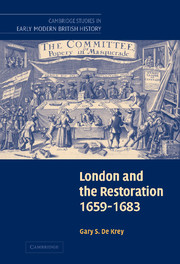Book contents
- Frontmatter
- Contents
- List of figures
- Map
- List of tables
- Preface
- List of abbreviations
- Part I Crisis, 1659–1660
- Introduction to Parts I and II: London and the nation
- 1 London and the origins of the Restoration, 1659–1660
- Part II Settlement and unsettlement, 1660–1679
- Part III Crisis, 1679–1682
- Part IV Crisis and conspiracy, 1682–1683
- Conclusion: London and the end of the Restoration
- Appendices
- Appendix I 1670 London dissenting subscription
- Appendix II London dissenting common councilmen, 1669–1671
- Appendix III Whig party leaders
- Appendix IV Tory party leaders
- Bibliography
- Index
- Titles in the series
Introduction to Parts I and II: London and the nation
Published online by Cambridge University Press: 07 May 2010
- Frontmatter
- Contents
- List of figures
- Map
- List of tables
- Preface
- List of abbreviations
- Part I Crisis, 1659–1660
- Introduction to Parts I and II: London and the nation
- 1 London and the origins of the Restoration, 1659–1660
- Part II Settlement and unsettlement, 1660–1679
- Part III Crisis, 1679–1682
- Part IV Crisis and conspiracy, 1682–1683
- Conclusion: London and the end of the Restoration
- Appendices
- Appendix I 1670 London dissenting subscription
- Appendix II London dissenting common councilmen, 1669–1671
- Appendix III Whig party leaders
- Appendix IV Tory party leaders
- Bibliography
- Index
- Titles in the series
Summary
LONDON AND THE CRISIS OF 1659–1660
When Charles II processed through the city of London on 29 May 1660, upon his return to England, the occasion marked more than a personal triumph for a king who had suffered a decade of political frustration after the execution of his father and the abolition of monarchy. Charles's return to the kingdom after years of exile and hardship was also a political and emotional catharsis for a city that had contributed more than any other locality to the collapse of Stuart monarchy in the 1640s. Charles's route was crowded and lined by the civic militia and by thousands of citizens drawn up in their guilds. The streets were hung with tapestries, pennants, banners, and spring flowers; and wine was said to be flowing in every conduit and fountain. The king's appearance was greeted by “such shouting as the oldest man alive never heard”; and this celebratory din was increased by the ringing of church bells and by the many trumpets and drums in the royal procession. Charles required four hours to pass through the city and Westminster to Whitehall, and popular rejoicing continued for another three days and nights.
The new king was well aware of the ironies of this frenzied London reception. Surely this could not have been the same city in which, less than a generation earlier, puritan crowds had competed with the parliamentary leadership in driving “reformation and liberty” at the expense of episcopacy and monarchy.
- Type
- Chapter
- Information
- London and the Restoration, 1659–1683 , pp. 3 - 18Publisher: Cambridge University PressPrint publication year: 2005
- 1
- Cited by



